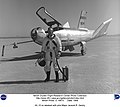File:Major Jerauld Gentry by HL-10 1968.jpg

Size of this preview: 766 × 600 pixels. Other resolutions: 307 × 240 pixels | 613 × 480 pixels | 981 × 768 pixels | 1,280 × 1,002 pixels | 2,560 × 2,005 pixels | 5,099 × 3,993 pixels.
Original file (5,099 × 3,993 pixels, file size: 8.64 MB, MIME type: image/jpeg)
File history
Click on a date/time to view the file as it appeared at that time.
| Date/Time | Thumbnail | Dimensions | User | Comment | |
|---|---|---|---|---|---|
| current | 23:30, 20 July 2009 |  | 5,099 × 3,993 (8.64 MB) | Skeet Shooter | Original image cropped to allow use of Wiki captions |
| 23:18, 20 July 2009 |  | 5,100 × 4,540 (7.89 MB) | Skeet Shooter | {{Information |Description={{en|1=Pilot Major Jerauld R. Gentry stands in front of the HL-10 Lifting Body. Gentry was the Air Force project pilot for the HL-10 while it was making the early glide and powered flights in 1968 following its modification. He |
File usage
The following pages on the English Wikipedia use this file (pages on other projects are not listed):


